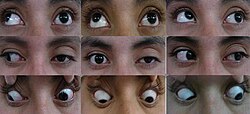Ophthalmoparesis

Editor-In-Chief: Prab R Tumpati, MD
Obesity, Sleep & Internal medicine
Founder, WikiMD Wellnesspedia &
W8MD medical weight loss NYC and sleep center NYC
| Ophthalmoparesis | |
|---|---|

| |
| Synonyms | Ophthalmoplegia |
| Pronounce | N/A |
| Specialty | N/A |
| Symptoms | Double vision, ptosis, strabismus |
| Complications | Vision impairment, diplopia |
| Onset | Varies |
| Duration | Varies |
| Types | N/A |
| Causes | Nerve damage, muscle disorders, myasthenia gravis, thyroid eye disease |
| Risks | Diabetes mellitus, hypertension, multiple sclerosis |
| Diagnosis | Clinical examination, MRI, CT scan |
| Differential diagnosis | Myasthenia gravis, thyroid eye disease, cranial nerve palsy |
| Prevention | N/A |
| Treatment | Corticosteroids, surgery, prism glasses |
| Medication | N/A |
| Prognosis | Depends on underlying cause |
| Frequency | Rare |
| Deaths | N/A |
A condition involving weakness of the eye muscles
Ophthalmoparesis is a condition characterized by weakness or partial paralysis of one or more of the extraocular muscles, which are responsible for controlling eye movements. This condition can affect one or both eyes and can lead to difficulties in eye movement, resulting in symptoms such as double vision (diplopia) and misalignment of the eyes (strabismus).
Causes[edit]
Ophthalmoparesis can be caused by a variety of factors, including:
- Neurological disorders such as multiple sclerosis or myasthenia gravis.
- Vascular diseases like diabetes mellitus or hypertension, which can lead to microvascular cranial nerve palsy.
- Infections that affect the cranial nerves, such as Lyme disease or syphilis.
- Trauma to the head or orbit, which can damage the nerves or muscles controlling eye movement.
- Tumors or aneurysms that compress the cranial nerves.
Symptoms[edit]
The primary symptoms of ophthalmoparesis include:
- Diplopia (double vision)
- Ptosis (drooping of the eyelid)
- Difficulty moving the eye in one or more directions
- Strabismus (misalignment of the eyes)
Diagnosis[edit]
Diagnosis of ophthalmoparesis typically involves a thorough clinical examination by an ophthalmologist or neurologist. This may include:
- Visual acuity tests
- Ocular motility tests to assess eye movement
- Neuroimaging techniques such as MRI or CT scan to identify any structural causes
- Blood tests to check for underlying systemic conditions
Treatment[edit]
The treatment of ophthalmoparesis depends on the underlying cause. Options may include:
- Medications to manage conditions like myasthenia gravis or multiple sclerosis
- Surgery to correct muscle or nerve issues
- Prism glasses to alleviate double vision
- Botulinum toxin injections to manage muscle imbalances
Prognosis[edit]
The prognosis for ophthalmoparesis varies depending on the cause. Some cases may resolve spontaneously, especially if they are due to microvascular issues, while others may require long-term management.
See also[edit]
Ad. Transform your life with W8MD's Budget GLP-1 injections from $75


W8MD offers a medical weight loss program to lose weight in Philadelphia. Our physician-supervised medical weight loss provides:
- Weight loss injections in NYC (generic and brand names):
- Zepbound / Mounjaro, Wegovy / Ozempic, Saxenda
- Most insurances accepted or discounted self-pay rates. We will obtain insurance prior authorizations if needed.
- Generic GLP1 weight loss injections from $75 for the starting dose.
- Also offer prescription weight loss medications including Phentermine, Qsymia, Diethylpropion, Contrave etc.
NYC weight loss doctor appointmentsNYC weight loss doctor appointments
Start your NYC weight loss journey today at our NYC medical weight loss and Philadelphia medical weight loss clinics.
- Call 718-946-5500 to lose weight in NYC or for medical weight loss in Philadelphia 215-676-2334.
- Tags:NYC medical weight loss, Philadelphia lose weight Zepbound NYC, Budget GLP1 weight loss injections, Wegovy Philadelphia, Wegovy NYC, Philadelphia medical weight loss, Brookly weight loss and Wegovy NYC
|
WikiMD's Wellness Encyclopedia |
| Let Food Be Thy Medicine Medicine Thy Food - Hippocrates |
Medical Disclaimer: WikiMD is not a substitute for professional medical advice. The information on WikiMD is provided as an information resource only, may be incorrect, outdated or misleading, and is not to be used or relied on for any diagnostic or treatment purposes. Please consult your health care provider before making any healthcare decisions or for guidance about a specific medical condition. WikiMD expressly disclaims responsibility, and shall have no liability, for any damages, loss, injury, or liability whatsoever suffered as a result of your reliance on the information contained in this site. By visiting this site you agree to the foregoing terms and conditions, which may from time to time be changed or supplemented by WikiMD. If you do not agree to the foregoing terms and conditions, you should not enter or use this site. See full disclaimer.
Credits:Most images are courtesy of Wikimedia commons, and templates, categories Wikipedia, licensed under CC BY SA or similar.
Translate this page: - East Asian
中文,
日本,
한국어,
South Asian
हिन्दी,
தமிழ்,
తెలుగు,
Urdu,
ಕನ್ನಡ,
Southeast Asian
Indonesian,
Vietnamese,
Thai,
မြန်မာဘာသာ,
বাংলা
European
español,
Deutsch,
français,
Greek,
português do Brasil,
polski,
română,
русский,
Nederlands,
norsk,
svenska,
suomi,
Italian
Middle Eastern & African
عربى,
Turkish,
Persian,
Hebrew,
Afrikaans,
isiZulu,
Kiswahili,
Other
Bulgarian,
Hungarian,
Czech,
Swedish,
മലയാളം,
मराठी,
ਪੰਜਾਬੀ,
ગુજરાતી,
Portuguese,
Ukrainian